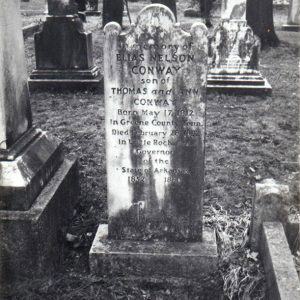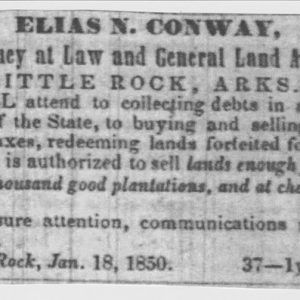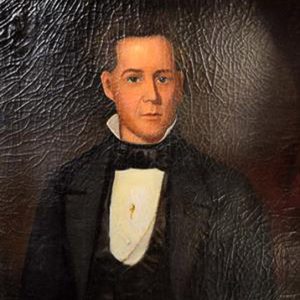calsfoundation@cals.org
Elias Nelson Conway (1812–1892)
Fifth Governor (1852–1860)
Elias Nelson Conway—born into an extended kinship group known as “The Family,” which came to dominate the politics of early Arkansas—was elected the fifth governor of the state of Arkansas. He served in that position longer than anyone until Orval Faubus, a century later. His eight years in office were a time of relative prosperity for the growing state as the government dealt with issues such as internal improvements and debt left from failed banks. The mounting tensions that led to the Civil War began to play out during Conway’s second term, and the voters ended the Family’s political domination in the election of 1860 when they rejected Conway’s choice for a successor.
Elias Conway was born on May 17, 1812, in Greeneville, Tennessee, to Thomas Conway, a planter, and Ann Rector. The youngest son of seven, and the ninth of ten children, Conway watched his brothers achieve prominence in public service in such positions as delegate to Congress, state Supreme Court judge, state surveyor general, and physician. His brother James Sevier Conway was the first governor of the state of Arkansas.
When he was six years old, Conway’s family moved to Missouri, first to Saint Louis County and then Howard County, and he received his formal education at the school of Alonzo Pearson and at Bonne Femme Academy in Boone County, Missouri. Following several of his brothers, he moved to Arkansas in 1833, where he was appointed U.S. deputy surveyor in 1834. On July 25, 1835, territorial governor William Savin Fulton appointed Conway territorial auditor to fill the unexpired term of William Pelham. The territorial assembly elected him to that position later in the year. Upon statehood, the Arkansas General Assembly made Conway the first auditor of the state, a position he held from 1836 to 1849, except for a six-week period in 1841 when A. Boileau served as acting auditor. Conway’s advocacy of distributing state lands to settlers who would live on them preceded the national Homestead Act by twenty years.
Ever active in Democratic Party politics, Conway received the Democratic nomination for governor at the party convention on December 5, 1843, a year after he became old enough to hold the office. Conway withdrew from the campaign after widespread criticism of the poorly attended convention and of Conway himself. The Conways, with their relatives the Seviers and the Johnsons, were called “The Family” or “The Dynasty” because of their domination of pre–Civil War politics in Arkansas; historian John Hallum totaled 188 years of public service by these cousins in nineteenth-century Arkansas. Conway’s youth and inexperience suggested to some that the Family had picked one of their own over a more qualified candidate. Democrat Thomas S. Drew was instead elected governor in 1844.
Conway lost his 1848 bid for reelection as auditor to Christopher Columbus Danley, a hero of the Mexican War, and returned to private life as an attorney and land agent. In 1852, the Democratic Party convention nominated Conway for governor. He was opposed by General Bryan H. Smithson, an independent Democrat endorsed by the Whigs. The key issue of the campaign became internal improvements, and Conway was labeled the “dirt roads candidate” for his conservative stance favoring good dirt roads over the uncertain promise of railroads. Conway won the election, garnering 15,442 votes to 12,414 for Smithson. Four years later, Conway defeated James Yell, the Know-Nothing Party candidate, by the margin of 27,612 to 15,249. His term of service—from November 15, 1852 to November 15, 1860—has been exceeded by only three Arkansas governors: Orval Faubus, and Bill Clinton, and Mike Huckabee.
The 1850s were a time of great excitement over the promise of railroads, stimulated in no small part by the California gold rush. Communities all over the state hoped to be connected to the nation by a rail system. In the 1853 meeting of the Arkansas General Assembly, five railroad companies were chartered, but it was not until after adjournment that Congress granted land to the state for railroads. One of the decade’s hottest debates in Arkansas politics occurred over competing proposals for terminus locations for the railroads and over Conway’s hesitation to call a special session to set the conditions for the dispersal of the federal land grants. Conway was closely allied with the organizers of the Cairo and Fulton Railroad and felt that the company needed time to proceed responsibly. He thought that a special session would be a waste of money. Conway also had recently appointed Family member United States Representative Robert Ward Johnson to the U.S. Senate, and he liked the idea of waiting to call the General Assembly to give Johnson time to get established before the assembly could vote to fill that position. Johnson was the brother of Conway’s private secretary, Richard H. Johnson, and the Senate seat had been recently vacated by Solon Borland, who had been appointed minister to Central America.
In the session of the General Assembly convened in November 1854, Conway suggested that the eastern end of the congressionally authorized railroad branch to the Mississippi River be located at Hopefield (Crittenden County), across the Mississippi River from Memphis, Tennessee, as opposed to Helena (Phillips County) or Napoleon (Desha County). He recommended that the route go through Clarendon (Monroe County) so that it could be shared by proposed railroads to the other two locations. The General Assembly picked Hopefield by one vote but allowed the Memphis and Little Rock Company to follow the most direct route through DeValls Bluff (Prairie County). Work proceeded, and on August 26, 1857, a locomotive named Little Rock carried dignitaries on the first railroad ride in Arkansas. The organizers of the Memphis and Little Rock Company named the second station on the route, which would have been in Crittenden County in 1857, in honor of Conway. The line between Hopefield and Madison (St. Francis County) on the St. Francis River opened for passengers and freight on November 11, 1858. While the line was extended during the last two years of Conway’s term in office, a completed connection between Little Rock and Memphis had to wait until after the Civil War.
Conway’s greatest triumph came in Arkansas’s ongoing battle with the Real Estate Bank. Created in the administration of his brother James, the State Bank and the Real Estate Bank were thought to be necessary components of a healthy, growing state. The failure of these two entities burdened the state with long-term debt and bad credit. The Real Estate Bank proved the toughest to deal with because it was not a government entity, but the faith of the state was pledged when its bonds were sold. That is, the state of Arkansas was supposed to cover the payments of interest and the repayment of principal when the Real Estate Bank no longer could make those payments. When the central board of the bank placed its affairs in liquidation, it did so by assigning all bank assets to appointed trustees, who happened to be board members of the bank. The state was excluded from the liquidation process but responsible for the debt. Conway’s strategy was to determine the financial situation of the bank and to transfer the bank’s assets to a receiver. He persuaded the General Assembly to create a new court of chancery in Pulaski County to place the bank in receivership, which took place on April 20, 1855. Conway planned to pay down the debt as far as the remaining assets would allow. At the end of his term in office, Conway proudly pointed to $2,341,996.17 paid on the state’s banking debts. But another $1,098,717.50 from the State Bank and $1,922,230.99 from the Real Estate Bank remained as a burden on the state, and Conway was unwilling to tax the citizenry to pay it off. After the Civil War, the state repudiated this debt.
Among his other accomplishments, Conway reformed swampland reclamation, improved the prison, successfully promoted the state’s takeover of the School for the Blind on February 4, 1859, and charged David Dale Owen with the production of Arkansas’s first geological survey. The 1850s saw the population of the state double and the plantation system of the Old South become firmly established, as the number of slaves in the state grew at an even higher rate than the white population. In spite of the cloud of debt hanging over it, the state enjoyed unparalleled prosperity during Conway’s time in office. He left $304,106.98 in the state treasury, strengthened the state’s monetary system by persuading the legislature to prohibit the circulation of low-denomination paper money, and reinforced the financial soundness of state government by using the pocket veto to prevent a tax reduction passed by the twelfth General Assembly. By one analysis, in 1860, Arkansas ranked sixteenth among the thirty-four states of the Union in per capita wealth, a comparative status which has never since been approached.
As tension mounted between the North and the South, Conway responded by proposing to the legislature that free African Americans be prohibited from living in Arkansas. While this proposal had been made before, Conway’s support and the national situation ensured its passage. Free black citizens not leaving the state after 1860 were to be enslaved for a year, with their earnings going toward their removal. The national situation provided an opportunity for opposition politicians, and Thomas C. Hindman in particular used his brand of Southern nationalism and personal ambition to work against the Family. He was elected to Congress and helped establish the Old Line Democrat newspaper to challenge the True Democrat, edited by Conway’s personal secretary, Richard H. Johnson. When the Democratic Party nominated Johnson for governor in 1860, former Family ally and kinsman Henry Massie Rector announced as an independent candidate with the support of the Old Line Democrat. He won the election, ending the Dynasty and its domination of Arkansas politics.
At the height of the Know-Nothing era, Elias Conway attended some services of the Roman Catholic Church and was enthusiastically criticized for it in the Arkansas State Gazette and Democrat. In suggestive terms, a commentary and poem of December 14, 1855, characterized Conway’s relationship with Johnson—“Miss Nancy Con-a-way” and “the organ grinder”—and implied that his association with the Catholic Church and Bishop Andrew Byrne might give Conway “false notions of ‘connubial felicity.’” This was possibly directed at Conway’s presumed sexual orientation. Conway never married, and he never joined a specific religious denomination.
In 1860, Conway retired to a quiet, near-reclusive life. He died more than three decades later on February 28, 1892, in Little Rock after falling headfirst into his fireplace. He is buried in Mount Holly Cemetery in Little Rock.
For additional information:
Bolton, Charles S. Arkansas, 1800–1860: Remote and Restless. Fayetteville: University of Arkansas Press, 1998.
Donovan, Timothy P., Willard B. Gatewood Jr., and Jeannie M. Whayne, eds. The Governors of Arkansas: Essays in Political Biography. 2nd ed. Fayetteville: University of Arkansas Press, 1995.
“Elias N. Conway Served As Governor Eight Years.” Arkansas Gazette. November 27, 1927. p.10.
Hallum, John. Biographical and Pictorial History of Arkansas. Easley, SC: Southern Historical Press, n.d.
Obituary of Elias Nelson Conway. Arkansas Democrat. February 29, 1892, p.1.
Obituary of Elias Nelson Conway. Arkansas Gazette, March 1, 1892, p.5.
William B. Worthen
Historic Arkansas Museum
This entry, originally published in Arkansas Biography: A Collection of Notable Lives, appears in the CALS Encyclopedia of Arkansas in an altered form. Arkansas Biography is available from the University of Arkansas Press.











Comments
No comments on this entry yet.